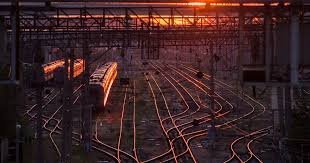
Introduction
Have you ever noticed that trains seem to run faster at night? Many travelers feel that nighttime journeys are quicker, smoother, and more efficient. But is it just a perception, or is there science behind it? In this blog, we will explore the factors that influence train speed at night and how Artificial Intelligence (AI) is revolutionizing railway operations to improve speed, safety, and efficiency.
Why Do Trains Run Faster at Night?
1. Less Traffic and Congestion
During the daytime, train tracks are busier with multiple trains running at different speeds—passenger trains, freight trains, and local transit. At night, the number of trains decreases, leading to:
- Fewer stops and delays
- Less waiting time at signals
- Smoother scheduling and coordination
2. Favorable Weather Conditions
Nighttime temperatures tend to be cooler, which can benefit train performance:
- Reduced track expansion: Heat causes tracks to expand, which can slow down trains for safety. Cooler nights reduce this effect.
- Better engine efficiency: Diesel and electric engines often perform better in cooler temperatures.
3. Streamlined Operations
Many rail networks schedule long-distance express trains at night, ensuring:
- Fewer stops compared to daytime commuter trains.
- Dedicated tracks, reducing delays.
- Higher average speeds, making nighttime journeys faster.
How AI is Revolutionizing Train Speed and Efficiency
Artificial Intelligence is playing a crucial role in making rail transport faster, safer, and more efficient. Here’s how:
1. AI-Powered Traffic Management
AI helps predict and prevent rail congestion by:
- Analyzing real-time train movements to optimize routes.
- Adjusting signal timings dynamically to minimize delays.
- Predicting peak travel times to reroute trains accordingly.
2. Smart Speed Optimization
AI algorithms calculate the optimal speed for trains based on:
- Track conditions
- Weather forecasts
- Real-time train schedules
- Fuel efficiency
This allows trains to run faster while consuming less energy, especially at night when conditions are ideal.
3. Predictive Maintenance for Tracks and Trains
AI-powered sensors monitor railway tracks and trains to detect issues before they cause delays.
- Machine learning models analyze data from tracks, signaling systems, and engines.
- AI predicts mechanical failures, ensuring maintenance is done proactively instead of reactively.
- This leads to smoother, uninterrupted night travel.
4. AI-Assisted Autonomous Trains
AI is paving the way for semi-autonomous and fully autonomous trains, which can:
- Adjust speeds dynamically for optimal performance.
- Reduce human errors, leading to faster and safer travel.
- Operate 24/7, making nighttime travel even more efficient.
5. AI in Weather Prediction for Train Safety
AI-driven weather forecasting helps trains adjust their speeds in response to conditions like:
- Fog
- Rain
- Snow
- Wind
At night, weather-related AI optimizations ensure trains maintain high speeds without compromising safety.
AI Revolution in Train Journeys
AI is transforming rail transport by making it faster, safer, and more efficient. Here are some more ways AI is revolutionizing train travel:
1.AI-Based Smart Ticketing & Passenger Flow Management
AI is enhancing passenger experience by:
Smart ticketing systems that use AI to predict demand and adjust ticket pricing dynamically.
Facial recognition & biometric check-ins to reduce waiting times at stations.
AI-powered crowd management to direct passengers to less crowded compartments, improving comfort.
2.AI-Driven Fuel Efficiency & Sustainability
AI helps optimize fuel and energy consumption, making train journeys more eco-friendly:
Adaptive cruise control ensures trains use the most efficient speed based on real-time data.
AI-based braking systems reduce energy waste and improve performance.
Smart energy grids adjust power distribution for electric trains, reducing carbon footprints.
3. AI for Security & Surveillance
AI-powered surveillance systems improve safety by:
Detecting unusual activities in real time using facial recognition and behavior analysis.
Identifying track obstructions or trespassing using drones and AI-powered cameras.
Preventing accidents by monitoring train interiors and alerting authorities in case of emergencies.
4. AI in High-Speed Rail Networks
AI is playing a key role in developing and managing high-speed rail (HSR) networks, ensuring:
Optimized track switching for smoother, uninterrupted travel.
Smart aerodynamics modeling to reduce air resistance and increase train speeds.
Real-time synchronization between multiple high-speed trains, preventing collisions.
5. AI for Real-Time Customer Assistance
AI-driven chatbots and virtual assistants are helping passengers by:
Providing real-time travel updates via mobile apps.
Assisting with ticket bookings and refunds using natural language processing (NLP).
Answering passenger queries about train schedules, delays, and alternative routes.
Conclusion
Trains often run faster at night due to less congestion, cooler temperatures, and optimized scheduling. AI is transforming railway systems by improving speed optimization, traffic management, predictive maintenance, and even autonomous train operations. As AI continues to evolve, train travel will become even faster, safer, and more efficient—whether during the day or at night.
Have you experienced faster train travel at night? Share your thoughts in the comments below! 🚆💨


1 Comment
Pingback: The Role of AI in Daily Use Within the Healthcare Sector - aiupdates.24xgoc.com